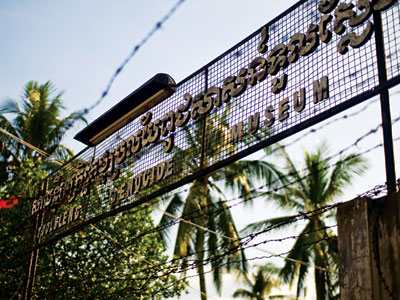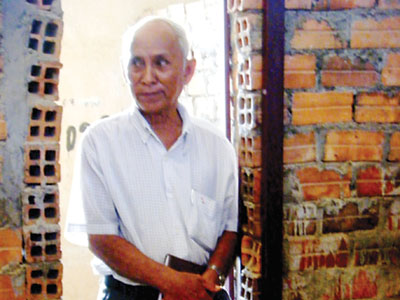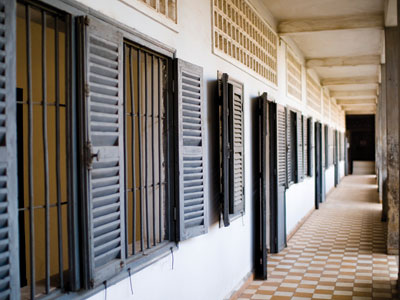The Torture at Tuol Sleng
The Torture at Tuol Sleng
Shocking and disturbing, Tuol Sleng Genocide Museum offers a portrait of anguish and suffering to help the world prevent new regimes from emerging. Giselle Whiteaker speaks to one of the four remaining survivors. Photos by Nick Ross.
Walking through the gates of Tuol Sleng Genocide Museum, I find it easy to recognise the layout as a former school. The buildings ring two central grassed courtyards, with several magnolia trees in full bloom, bringing to mind laughing school children at play. This image is quick to change.
Outside the first building are the graves of fourteen victims whose bodies were discovered at the prison on Jan 9, 1979. These were the last prisoners to be executed by the prison personnel before they fled. The simple white boxes are an innocuous start to a confronting education on the atrocities committed at Security Office 21 (S-21).
S-21 was created on Pol Pot’s orders in April, 1975. The museum pamphlet describes it as “…designed for detention, interrogation, inhuman torture and killing after confession.” This does not convey the true horror of the facility. Prisoner records give an official figure of 10,519 detainees, excluding children. Unofficial figures range from 14,000 to 20,000. Only seven survived. Prisoners were detained for two to three months, routinely tortured, then executed or sent to Choeung Ek killing fields.
Rules of Incarceration
The buildings have been preserved largely as they were found. The first building was converted from classrooms into a set of 6x4 rooms with glass panelled windows for soundproofing. Each room contains a rusting iron bed frame, shackles and an iron box. The walls and floors are stained. Hanging in each room is a black and white photograph showing the mutilated occupant of the room on discovery. These are the souls resting in the graves outside. Somewhat bizarrely, a number of today’s visitors pose by these photographs for their own shots.
Outside this building is a translated sign with the rules of incarceration, allegedly detailed to the prisoners on arrival. These include: “You must answer accordingly to my questions. Do not turn them away.” and “While getting lashes or electrification you must not cry at all.”
Inside the next building are hundreds of prisoner photographs. The majority look young and afraid. Some are children. Most photographs were separated from their accompanying documentation, leaving many people unidentified.
With a heavy heart I move to the other side of the compound. There are no visitors here yet. The façade of the first building is covered in a net of barbed wire. Stepping inside the wire I notice painted numbers on the wall, representing cells. These rooms are divided into eight two-metre units made of brick. A pang of sorrow passes through me. It’s as if the intense suffering has permeated the walls and is radiating outwards, engulfing anyone who comes close.
As other visitors trickle over, each falls silent close to the building. No one is taking photographs here. I take a few deep breaths and push myself mentally through the doorway.
In each cell is a bolt on the floor. Some contain shackles, some the metal boxes. On the second floor the cells are made of wood. Each cell here has a heavy door with a small opening for observation. Doorways have been crudely hacked into the walls between rooms to allow for guard access.
Keep For Awhile
Sitting in his cell I find Chum Mey, president of the Victims Association of Democratic Kampuchea, talking to a small group of visitors. He is one of the four known living survivors of Tuol Sleng and was the leading witness in the trial against the senior Khmer Rouge figure known as Comrade Duch. Comrade Duch was sentenced to a 30-year sentence in July 2010.
Sent to Tuol Sleng on charges of subversion, Chum Mey recounts how he was blindfolded and pulled into the cell by his ear. Here he was stripped to his underwear and chained to the floor. To change position required permission from the guards, two of whom patrolled each section to prevent the prisoners from communicating with each other.
“We had to use this as our latrine,” he says, picking up the metal box in his cell. He explains that if the prisoners were not accurate with their ablutions they were beaten. He recounts being hit with bamboo switches, having his toenails removed with pliers and being subjected to electric shocks to force a confession. He believes he was kept alive due to his skills as a mechanic. A note at the end of his written confession, penned by Comrade Duch, reads, "Keep for a while."
When the Vietnamese troops captured Phnom Penh, the S-21 prison staff fled and took Chum Mey with them. In a tragic twist of fate he was reunited en route with his wife and son who had been imprisoned at Prey Sar re-education camp, only to have the soldiers open fire two days later. His wife and son were shot dead and he escaped into the woods
Finding Peace
Ironically, he now spends many of his days at Tuol Sleng. In an interview with Michael Saliba, J.D. posted on the Cambodia Tribunal Monitor, he explained, “I come every day to tell the world the truth about the Tuol Sleng prison… I think it is important to expose the truth… so that none of these crimes are ever repeated anywhere in the world.”
Emotionally overwhelmed, in the fourth building I find a poster for an old photography exhibition by Stefan V. Jensen of reflected images on the prisoner portraits. The images give a ghostly air, lending credence to the Khmer belief that a person not given a proper burial lives on as a ghost unable to find peace. Perhaps this explains the sense of unease that cloaks the museum.
In the final room there are skulls displayed in glass cases. A Japanese tour group has left a string of 1,000 paper cranes, a wish for world peace and understanding, echoing Chum Mey’s sentiments.
Tuol Sleng is not an easy place to visit, and is definitely not suitable for children, but for an understanding of the effects of a brutal regime, it is extremely thought provoking.
Donations can be made to Ksem Ksan, the Victim’s Association of Democratic Kampuchea, through their website at www.ksemksan.org. Tuol Sleng Genocide Museum is located on Street 113, Sangkat beoung Keng Kang III, Khan Charmkarmorn, Phnom Penh. Tel: +855 23 216 045. Visit www.tuolslengmuseum.com for more info.
~~~~~~~~~~~~~~~~~~~~~~~~~~~~~~~~~~~~~~~~~~~~~~~~~~~~~~~~~~~~~~~~~~~~~~~~~~~~~~~~~~~~~~~
Republished with the kind permission of The Word HCMC

- 13709 reads
- Printer-friendly version



